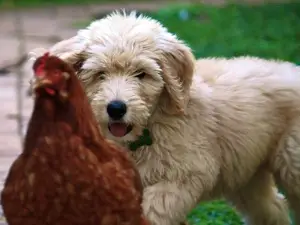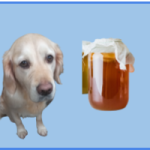
In today’s post, I want to write a very detailed guide to whether your dog should eat chicken.
And I want to stay by looking at when dogs and chickens were domesticated by man.
It is thought that dogs were domesticated around about thirty thousand years ago.
Of the 40 odd species that have been domesticated, dogs were one of the first.
A full ten thousand years before horses and cattle.
Whereas chickens came into our lives much later- somewhere between 6000 BC and 2000 BC, in parts of South Asia.
An interesting question to me is how many thousands of years have dogs been eating chicken…
In the next section, I will bring us bang up to date as I look at how popular chicken is in the US today.
Table of Contents
- How much chicken is eaten in the U.S?
- What is the nutrition in chicken?
- What do dogs need in their diet?
- Why do dogs need protein in their diet?
- Why do dogs need fat in their diet?
- Why do dogs need vitamins in their diet?
- Why do dogs need minerals in their diet?
- How cheap is chicken?
- What bacteria can be hiding in raw chicken?
- Can a dog digest raw and infected chicken?
- 60% of dogs eat raw chicken safely
- The hidden danger of dogs eating raw chicken…
- How should you prepare raw chicken for your dog?
- Can dogs eat chicken bones?
- How much chicken should I feed to my dog daily?
- How much chicken can a puppy eat?
- Can dogs eat BBQ chicken?
- My dog swallowed a whole chicken wing..
- Should my dog eat sesame chicken?
- Can my dog eat chicken stock cubes?
- Can dogs have Rotisserie Chicken?
- Can dogs eat chicken?
How much chicken is eaten in the U.S?
Staggeringly, Americans are eating twice as much chicken now as they did fifty years ago.
Eight billion chickens are eaten every year in the US.
In the 1970s the average person ate around a pound (half a kilogram) of chicken a week or fifty pounds per year, whereas now it is more than one hundred pounds (50 kgs.)
And it stands to reason that if people eat so much chicken and are so keen on it, that it will become a popular food for our dogs.
In the next section I want to look at what dogs get from chicken as I look in detail at its nutrition.
What is the nutrition in chicken?
There are very few parts of a chicken that aren’t eaten- as far as our dogs are concerned.
Breasts, thighs, legs, wings, feet, necks, livers, heart, gizzards and skin are all fed to dogs.
Overall chicken is known as a meat that contains little fat but is high in protein but do the individual cuts or parts of a chicken vary that much?
Let’s take a look.
I have split this nutrition section into two.
The first section will deal with popular cuts of chicken or the parts of the chicken that we often eat ourselves.
They are widely available and cheap.
The second section will be parts of the chicken that will be found not in grocery stores but in pet stores selling dog food.
Nutrition in popular cuts of chicken
But first, let’s take a look at the nutrition in the more desirable cuts of chicken.
I have created a chart that shows the most important values.
| 100g serving | Breast (no skin) | Breast (skin on) | Thigh* | Leg* | Wings | Skin |
| Calories | 176 | 181 | 175 | 155 | 247 | 450 |
| Fat | 5.5 g | 8.3 g | 8.6 g | 5.9 g | 17 g | 40 g |
| Cholesterol | 96 mg | 92 mg | 140 mg | 126 mg | 69 mg | 82 mg |
| Protein | 30 g | 25 g | 24 g | 24 g | 23 g | 20 g |
| Minerals | Phosphorous, Selenium, Zinc | Iron, Phosphorous, Selenium, Zinc | Iron, Phosphorous, Selenium, Zinc | Phosphorous, Selenium, Zinc | Phosphorous, Selenium, | |
| Vitamins | B2, B3, B6 | B3, B6, B12 | B3, B6 | B3, B6 | B3 |
*The values for these cuts of chicken are “skinless”.
For the most part, across all of these different cuts, I think that the values are very similar.
The real difference is with where the cuts have skin on.
The difference between a skinless breast and a breast with skin is that there is more fat and less protein.
Chicken wings, because of all the skin, also have more fat and less protein.
And to help you some more, I have included a column which shows the nutrients in chicken skin.
Which when you see that it is 40% fat, doesn’t leave much room for other nutrients!
Nutrition in less popular chicken cuts
In this section, I will move on and quickly look at some of the more unsavoury parts of a chicken.
Parts that in places like the US or UK are mostly eaten by dogs.
But the body parts that I have included below still have lots of nutrition and so it is great that these parts aren’t just being wasted.
The most important stats are in the chart below.
| 100g serving | Feet | Necks | Liver | Heart |
| Calories | 215 | 154 | 119 | 153 |
| Fat | 15 g | 8.8 g | 4.8g | 9.3 g |
| Cholesterol | 84 mg | 83 mg | 345 mg | 136 mg |
| Protein | 19 g | 18 g | 17 g | 16 g |
| Minerals | Copper, Phosphorous | Phosphorous, Selenium | Iron, Copper, Phosphorous, Selenium | Iron, Copper, Phosphorous, |
| Vitamins | B12, B9 | B3, B5, B6 | A, B12, B2, B5 [!] | B12 [!], B2, B5 |
So that I don’t get too bogged down in details I will just make a few points about the nutrition to be found in each of these body parts.
Firstly, chicken feet are easy and delicious snacks or training treats to feed to your dog but you have to because there is so much skin, the fat content is quite high.
Chicken liver should only be given to your dog in very small quantities- about 5% of their overall diet in fact.
And it isn’t about calories or protein but it is all about the vitamins.
Chicken liver contains massive amounts of vitamins A, B12, B2 and B5.
And when I say massive, I mean that a 100g portion would provide even a large dog with many times the amounts of these vitamins that they need in a day.
Don’t worry, your dog won’t be poisoned by having too much liver on a couple of occasions but the liver is a part of the chicken that we need to feed to our dog with extreme care.
I have written a more detailed article about it here.
But having established some precisely what the nutrients are in most parts of a chicken, in the next section I will start to discuss what a dog truly needs in their diet and where chicken fits into that.
What do dogs need in their diet?
There are two schools of thought here.
The first school is the Association of American Feed Control Officials (AAFCO).
The second school are the people who believe that dogs should be fed a raw meat diet.
AAFCO is responsible for deciding what should be in the food of any animal in the US.
As far as dogs are concerned, their guidelines should be followed by any company that sells dry or wet dog food.
Now, they don’t tell us how much chicken should be in the diet of a dog but they do provide details of how much fat or protein should be in a diet.
And here are the numbers.
For the moment, I will just look at numbers for an adult dog-as opposed to puppies or pregnant bitches.
A dog needs four different nutrients in its food-protein, fat, minerals and vitamins.
What no carbs?! Yes, dogs don’t need carbs.
| Protein | 18% |
| Fats | 5.5% |
| Minerals [selected] | Potassium (0.6%) Calcium (.5%) Phosphorous (.4%), Iron (mg/ kg), Zinc (80 mg/ kg) |
| Vitamins[selected] | A (5000 IU/ kg) D (500 IU/ kg) E (50 IU / kg) B2 (5.2 mg/ kg) B3 (13.6 mg/kg) |
And chicken provides all of these essential nutrients.
But does it provide them in the right quantities?
All will be revealed in the next section…
The second school of thought, supporters of the raw food diet, believe that dogs need three nutrients in their food- muscle meat, bone and offal.
Some people will also add vegetables and seeds to the diet.
| Muscle meat | 80% | 70% |
| bones | 10% | 10% |
| Offal | 10% | 10% |
| Vegetables and seeds | 0% | 10% |
I will quickly explain a few of these “terms”.
Muscle meats are things like legs and shoulders and breasts and thighs.
Offal are the internal organs of an animal- of which the liver is the most important for a dog.
Having looked at what the experts say about the exact needs that a dog has from their diet, it is time to double back a bit on ourselves and start to look at how the different nutrients in chicken might help our dogs.
Why do dogs need protein in their diet?
According to AAFCO requirements, dogs need about 18% protein in their diet, and so in this respect most human cuts of chicken over deliver- providing anywhere between 24%- 30%.
And as part of a balanced diet, the higher than needed protein content of chicken shouldn’t worry you too much.
Protein is crucial for a dog and it plays a complex but crucial role in their health and well being.
It is a building block of life and it helps to create different cells within the body and to keep them healthy.
These cells in turn form into muscle and other body tissues.
Some hormones are also made out of protein.
More obviously, protein is important when it comes to creating and maintaining hair, skin and nails.
We can get even more nerdy and detail oriented if you like.
Going back to our original AAFCO document (about what should be in a dog’s diet) it tells us exactly what proteins a dog needs.
Proteins such as arginine, histidine and leucine for instance.
And chicken is high in arginine (which helps with wound healing and boosting the immune system) , histidine (which helps with memory and brain function) and leucine (which helps to control blood sugar levels among other things!
Having looked at the power of protein, I want to move on and examine the controversial role that fat plays in the health of our dogs.
Why do dogs need fat in their diet?
You heard me right. I said the role that fat plays in the health of our dogs.
And although fat has been demonised in the media, humans and dogs need some fat in order to survive and thrive.
We know that adult dogs need about 5.5% fat in their diet.
And from our nutrition charts, we know that skinless chicken breasts and skinless chicken thighs provide between 5-6% fat and so in that respect these cuts of chicken are spot on.
But what role does fat play in a dog’s body?
Fat, in the right proportion, is important to a dog for many reasons- and I won’t list all of them here.
Firstly, it is a concentrated form of energy which a dog’s body will use up before it looks to digest carbohydrates and proteins.
Secondly, fats contain essential fatty acids which contain nutrients that a dog can only get by eating fat.
These acids are called Omega 3 and Omega 6. You might have heard of them?!
Finally, fat is important because it helps dogs to absorb certain vitamins, such as vitamin A and D.
Without fat dogs couldn’t absorb these vitamins in their bodies.
And talking of vitamins, in the next section I want to look at how the vitamins which are found in chicken are helpful to dogs.
Why do dogs need vitamins in their diet?
Chicken contains lots of different vitamins but the ones which are most abundant are vitamins B3 and vitamin B6.
Which is fortunate because a dog needs to eat both of these vitamins as part of a healthy diet.
Vitamin B3 (Niacin) is important to a healthy dog because it helps to turn their food into energy.
It is a vitamin that helps to break down and absorb fatty acids (and those were mentioned not long ago.)
It will also help your dog to regulate and control their hormones.
So, what does vitamin B6 do?
Vitamin B6 (or pyridoxine) comes across to me as something of a powerhouse in terms of all the different pies that it has its fingers stuck into.
It’s crucial in the creation and maintenance of red blood cells and glucose. And it is said to also boost the immune system.
And to close out this section of the article, I want to take a closer look at how the minerals contained in chicken will help your dog.
Why do dogs need minerals in their diet?
According to the AAFCO, dogs need twelve different minerals in their diet.
These are: calcium, phosphorus, potassium, sodium chloride, magnesium, iron, manganese, copper, zinc, iodine and selenium.
As far as I can tell chicken contains all of them apart from iodine or manganese.
It is particularly abundant in three different minerals- Phosphorus, Selenium and Zinc.
Some different cuts of chicken also contain high levels of iron as well.
It is all well and good us banging on about how great chicken is if it is a food that is hard to get hold of or incredibly expensive.
Fortunately, in the next section I will look at this vexing issue.
How cheap is chicken?
This is a very difficult question to give a simple answer to because in part it depends on where you live and the price of any food goes up and down week by week.
However, this chart of food prices from the US Bureau of Labor Statistics gives us a great average to use.
And it is up to date with prices from December 2021.
And the news as far as chicken is concerned is very good indeed.
It is the cheapest meat available.
These are the average prices for different cuts of chicken.
All the prices are per lb.
| Whole chicken | $1.60 |
| Boneless breast | $3.75 |
| Legs (with bone) | $1.72 |
In comparison, a pound of ground beef will cost you $4.60 and a pound of boneless chops will cost $4.40.
So chicken breast is over $1 cheaper than ground beef or pork chops.
Before we get over excited about all the good news that chicken brings, it is important to shine a light on some of the potential downsides.
And they include the fact that chicken might contain some harmful bacteria.
More on that in the next section.
What bacteria can be hiding in raw chicken?
According to the CDC (Centre of Disease Control) “raw chicken is often contaminated with Campylobacter bacteria and sometimes with Salmonella and Clostridium perfringens bacteria.”
And these bacteria pose an immense threat to human health. Every year one million Americans get sick from eating contaminated chicken.
Raw chicken is the biggest cause of food poisoning hospitalisations and deaths in the U.S.
Information collected in 2018 showed that up to 4% of all chicken meat in supermarkets was infected with salmonella.
But as I said, that data relates to humans not dogs.
So this begs the question, can dogs get ill from eating raw chicken?
Dogs can become ill with campylobacter and salmonella but it is highly unlikely that they will become seriously ill with either of these two types of bacteria.
And the reasons for this will be explained a bit more as I discuss the inner workings of a dog’s stomach.
Can a dog digest raw and infected chicken?
It would be easy to get a bit gung ho about thinking that our dogs can eat almost anything without coming to any serious harm.
It is true enough that a dog’s stomach and digestion system work in a completely different way to the way that a person’s stomach “operates” but we should still be cautious.
Older dogs, puppies and dogs with a pre-existing medical condition are more vulnerable to campylobacter and salmonella infections and so you need to think very carefully about your dog as an individual.
The acid in a dog’s stomach during digestion is below ph1.
To all of you non scientists out there, ph1 is similar to the acidity of car battery acid, and we know from some of those movies about Mafia gangsters how potent car battery acid is!
At this strength, meat and bones are dissolved in a few hours and so, it is thought, will any harmful bacteria.
And all of this leads us to a discussion about dogs who are routinely eating chicken as part of a raw food diet.
60% of dogs eat raw chicken safely
Did that headline get your attention?
Well let me explain it because all is not quite as it seems.
60% of dogs in the Netherlands are on a raw food diet, whereas the figures for places such as the US and Australia are around 16%.
It is thought that there are almost ninety million dogs in the US, which means that nearly 18 million dogs are on a raw food diet.
And if raw chicken was that dangerous, surely there would have been a catastrophic campylobacter or salmonella outbreak by now, wouldn’t there?
But it might be that people aren’t concerned about the welfare of dogs, they are more concerned about our welfare.
And we will find out why in the next section.
The hidden danger of dogs eating raw chicken…
As the popularity of raw pet food diets has grown over the past decade or so, scientists have been concerned that as more raw meat is handled by people, the risk to human health increases.
The main body in the US with responsibility for the prevention of any diseases is dead against pets being fed raw food because if the meat isn’t handled properly and hygienically, people could become infected.
But an international survey of pet owners who fed their pets raw food was carried out in 2019.
The survey received responses from over sixteen thousand people and found that only .24% of households had a case of food poisoning as a result of feeding their dog or cat raw food.
I think the truth of the matter is that not enough research has been done about the issue.
But, saying that, how should you prepare raw chicken for your dog?
How should you prepare raw chicken for your dog?
The important part of handling any raw meat (chicken or pork) for dogs or for people is to only use clean utensils and equipment and then to wash the equipment, wipe the surfaces and wash your hands in hot soapy water.
Don’t be tempted to either use the equipment for something else before it has been washed or to wash the chicken before you give it to your dog.
Washing chicken will just increase the chances of spreading infection as the water bounces off the chicken onto your kitchen surfaces.
There is an important part of a chicken (as far as your dog is concerned) that I have yet to address.
In the next section I will talk about chicken bones.
Can dogs eat chicken bones?
This topic could warrant a mega guide of its own but I promise to keep this a bit brief.
The topic of dogs and bones is surprisingly contentious considering that bone eating for dogs is in their DNA.
Some people think that dogs should have regular access to bones, others think that dogs shouldn’t be given bones because they are potentially dangerous to dogs.
There are a few important guidelines to follow when it comes to bones.
Firstly, you should always give your dog raw bones, not cooked bones.
Cooked bones are too hard for a dog to chew and can easily splinter.
Secondly, dogs should be fed the weight bearing bones of any animal- chickens included.
Weight bearing bones are denser and less likely to splinter than non weight bearing bones.
And finally you need to consider the size of the bone to the size of your dog’s mouth.
The bone needs to be large enough for the dog to gnaw it and not try to swallow it whole- where it might get stuck in your dog’s throat.
So, where does that leave us with chicken bones?
I think for small dogs who aren’t aggressive chewers, chicken leg bones will be fine.
For bigger dogs, if you want to give them a bone, you need to find raw bones from bigger animals- such as cows and pigs.
As this article heads into the “home straight”, I want to give you a few brief answers to some popular questions about whether dogs can eat chicken.
And the reason that my answers will be brief is because I have dedicated a whole post elsewhere on my site to answer the question in much more detail.
How much chicken should I feed to my dog daily?
Whenever we start something new, we are looking for very precise answers.
And the question about how much chicken a dog should be fed on a daily basis is a case in point.
To help you on your way, I provide a couple of methods for calculating the precise amounts that your dog needs- one of these methods is to feed them about 3% of their body weight in chicken.
But I also discuss how getting into a rut and feeding your dog chicken day in and day out isn’t a good idea.
Because however nutritious chicken is, our dogs need variety.
If you want to find out more, read this article.
How much chicken can a puppy eat?
If the article in the previous section mostly dealt with the needs of adult dogs, this article looks at chicken from the point of view of puppies.
Many of you might wonder if puppies should be fed chicken at all!
Chicken will provide your puppy with lots of nutrition, although like older dogs you don’t just want to feed them chicken.
And since puppies are more vulnerable than older dogs, you might want to feed them cooked chicken, not raw chicken.
And the best (and simplest) way of cooking chicken for your puppy is to boil it.
If you want more details, go here.
Can dogs eat BBQ chicken?
Everybody loves a barbecue.
There are few better ways of bringing people together on a beautiful day than firing up the garden grill and cooking some meat.
When I say everyone loves a BBQ, I include our dogs.
Most dogs love the combination of a crowd of people, some sunshine and some BBQ’d meat.
The bottom line is that dog’s can eat a bite or two of bbq chicken.
The sauce often contains ingredients that aren’t very healthy for your dog and some ingredients such as onion and garlic are toxic for dogs.
Many barbecues also involve lots of alcohol which might present your dog with a few opportunities to eat far more chicken than they ought.
Stay alert and click here to find out how to keep your dog safe when you are barbecuing chicken.
My dog swallowed a whole chicken wing..
The dangers of a dog swallowing a piece of meat or in this case a bit of meat and a bone.
If your dog swallows a whole chicken wing and you are there to watch, it is a frightening thing to behold.
It is quite shocking- you pass your dog a wing and expect them to crunch it a few times.
But, oh no, like a performing sea lion with a fish, your dog just swallowed the wing whole, no crunching necessary.
Most dogs will probably be totally fine.
They might lick their lips and look at you as if to say, “what were you worried about?”
But whole chicken wings are a dangerous size for most dogs- just think about the size of a wing compared to the size of your dog’s throat for instance.
If you want more advice on what to do, head over to here.
Should my dog eat sesame chicken?
If BBQs aren’t your thing, maybe eating Chinese food is.
With sesame chicken being a particular weakness.
Similar to bbq chicken, sesame chicken is a very rich food, which doesn’t appear on any list of healthy foods to feed to your dog.
But unlike BBQ chicken, the ingredients in most sesame chicken sauces aren’t toxic at all to your dog.
So, that will give you a bit of leeway, if you want to be a bit naughty with that Chinese takeaway on a Friday night!
Can my dog eat chicken stock cubes?
If you are looking to boost the flavour in any meal, there are few quicker ways than adding a stock cube.
But how safe are they for your dog?
Perhaps your dog is a picky eater and you are desperate to make their dull meal of kibble more interesting.
Or your dog might be dehydrated and need to drink some water, pronto!
Are chicken stock cubes the way to go?
Whatever your situation, this post will provide you with the most important information.
Can dogs have Rotisserie Chicken?
If you want a ready to eat and tasty chicken which is cooked fairly plainly, then you might opt for a rotisserie chicken.
But the trouble with whole chickens, even when you are feeding a few people, is that there will always be left overs.
And how dog friendly are these “rotisserie” leftovers?
Well, as this post explains, the biggest thing to bear in mind with a rotisserie chicken is how much salt it contains.
And whilst the amount of salt used to cook one of these chickens won’t poison your dog, adding too much salt into your dog’s diet isn’t the healthy thing to do.
Can dogs eat chicken?
And there we have it, this epic deep dive into whether dogs can have chicken is over.
It isn’t a surprise that the answer is a qualified “yes, dogs can have chicken in their diet”.
And as far as dogs are concerned, there are so many parts of a chicken to choose from.
Hopefully I have provided you with enough nutritional information about each chicken body part , for you to make the best choice for your dog.
As for whether or not you should feed your dog raw chicken or chicken bones, that is up to you.
Just go over some of the advice that I have provided in this article and start off small and slow!
Photo credits
¹ Photo by Daniel Pink on Flickr






